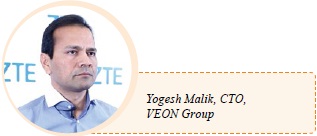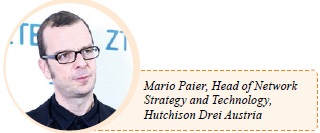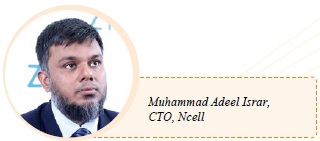Interviews with Global Operators on 5G, ZTE
5G is a major technology trend that will bring big changes in the future. ZTE is focusing on the development of 5G to help operators meet new challenges and opportunities. In a series of interviews during MWC 2018, ZTE’s partners across the world talked about the prospects of 5G and their cooperation with ZTE.

Where do you see the future of Pan 5G including 5G connection, bearing, services, and terminals?
We see that we are living in exponential times. 5G in my view provides a platform. A platform, which is beyond radio. It goes into end-to-end user possibilities. For users, I don’t mean human beings but objects. Therefore, 5G creates a platform for us as operators to really create a connected society. It is an enabler. We need to see that 5G-only radio speeds should not confuse us. It is end to end. It is about network slicing. It is QoS. It is really giving enterprise customers a new value and it is coming with a connected society at home, giving users the same flexibility if not more.
What do you think about ZTE's Pan 5G innovations?
I have to say that the ZTE booth has a refreshing look, and the reason is that the focus is on the creation of the future network. The focus is not only on radio, not only on application, but transport in the middle, which needs to be extremely focused, because that is where the choking point will be. Therefore, core and transport innovation is right in the center. I am very proud to see that our strategic partner is focusing on those areas, because this industry has been focusing on radio speed, the billing system, and others. What we have left out is core and transport, and modernization of the back-end infrastructure, which allows us to come closer to the customer.
Could you talk about the collaboration with ZTE on Pan 5G?
ZTE has been our trusted and strategic partner. Actually, we have gone a long way in virtualization with ZTE. We have managed to virtualize network functions, EPC and SDM. We have managed to go for IMS. We have managed to do messaging. All these are on an open platform. I think that is why I like the ZTE architecture a lot. Now having said that, a challenge now is how to bring 4G to 5G in the investment case so that we cannot only justify connected society but we can also bring on the new purpose. In addition, I think that is where we are working very well with ZTE. My focus is going to be on the super cities. I want every urban city to become a super city and to be able to connect the society in a way so that we are more intelligent and data can help us make our lives better.
 Where do you see the future of Pan 5G including 5G connection, bearing, services, and terminals?
Where do you see the future of Pan 5G including 5G connection, bearing, services, and terminals?
We are on a great journey. 5G or Pan 5G is a new environment but it is already available today. What we have done in velcom together with our partner ZTE is exactly to start this today because we are starting at the core. Network slicing, for instance, brings new services. It is starting with the core. For the radio part, we have already developed 4G quite further; and 5G will help us have a better system here. In the end, core network and the radio part connected with a very capable transport network have to be orchestrated. This will be the all of it because we will not be able to handle it any longer through people management. We have to do it in a fully automated way. This journey has started already. NB-IoT is the first service where we have done network slicing—we have put it onto a fully virtualized environment. Now of course it’s the orchestration which will be next. We are excited to follow with ZTE on this journey.
Could you talk about the cooperation with ZTE on Pan 5G?
The cooperation of ZTE and velcom started about three years ago. The first part was software-defined radio, which means we are able to move towards 5G, 6G or whatever is coming. The next part was core network virtualization, swapping to a fully virtualized network, and the last part for us is connectivity. Transport is at the moment ongoing and again it is the partnership of ZTE with velcom. This is bringing SDN capability to enable a fast network, which has all the capabilities to be flexible enough and to deal with the demand of many different service clouds in the future. We have chosen a partner because, for our market, it is a perfect fit to push things early to the edge of technology.
What do think of ZTE's Pan 5G innovations and future collaborations?
ZTE is a partner with whom we are dealing very well on this journey towards Pan 5G. In several elements ZTE has shown they are really advanced. For instance, the virtualization. We believed they were able to do it well and they delivered together with us the first fully virtualized core network. Things that we are now planning together are I think a very good symbol of what is possible to do in a partnership. ZTE is showing in some elements like orchestration and open stack that they are so much more advanced that I think 5G is tangible very soon. I hope next year that we are nearly able to have an end-to-end complete solution. Of course there are many more partners involved. However, ZTE is, I think in the industry, one of the big players that will push it forward, and I am very proud that we are here already, in the country of Belarus, pushing substantial things towards 5G.
 Where do you see the future for Pan 5G including 5G connection, bearing, services, and terminals?
Where do you see the future for Pan 5G including 5G connection, bearing, services, and terminals?
As an operator, it is very important to have end-to-end 5G solutions. This begins in the radio part, includes transmission, core network and the service platforms. 5G will have several dimensions: very high capacity, very high data speeds, low latency, and very high reliability. We have to plan where we implement which functions with which target KPIs. This means that we have to do it very carefully and we need providers like ZTE to help us to develop solutions together.
Could you talk about the cooperation with ZTE on Pan 5G?
We have been working with ZTE for more than 8 years now. We started with 3G and implemented full 3G coverage in Austria. Then we upgraded the whole network to 4G. In the meantime, we have 85 percent of the traffic on 4G. The next step will be 5G. We have already started to implement first trials with pre-5G Massive MIMO.
What do you think of ZTE's 5G innovations and future collaborations?
I think ZTE is quite strong in 5G development. ZTE was the first to provide solutions for Massive MIMO. One and a half year ago in Austria, we already tested Massive MIMO. Also in the core network, ZTE is quite strong with architectures and solutions for telecom platforms. We think it is a good way to collaborate with ZTE to develop solutions together.
 Where do you see the future for Pan 5G including 5G connection, bearing, services, and terminals?
Where do you see the future for Pan 5G including 5G connection, bearing, services, and terminals?
The future 5G is really simple. It is a massive enabler. So in terms of taking the industry forward and converging a number of other aspects of multiple industries, 5G is going to be the biggest enabler of technology to be paired up with practical execution within the environments where we are working. 5G allows so many things to take place that were never able to be done in the traditional GSM network. As a result, 5G will liberate the markets where it is launched at speeds that we have never seen before. I do not mean network speeds. I mean speeds of innovation, speeds of deployment, speeds of being able to get results for many of the challenges we are experiencing globally at the moment. It is industry-agnostic in a lot of respects as an enabler that goes through multiple facets from health to automation to automobiles and AI. It allows the backbone to be the connector of everything and it will become synonymous with the way people live and go forward.
Could you talk about the cooperation with ZTE on Pan 5G?
ZTE as a strategic partner with us has been exceptional in terms of looking at collaboration and roadmaps towards being able to get us onto 5G evolution. We’ll look at what we will do with ZTE going forward in terms of understanding the 5G roadmap, developing certain strategies around 5G and how we operate within the 5G environment.
What do you think of ZTE's 5G innovations and future collaborations?
When we look at ZTE’s offerings at MWC, it is very exciting to see that ZTE is at the forefront of the 5G roadmap. They are highly competitive as a 5G infrastructure provider. They understand where the customers’ ambitions lie in terms of making use of technologies, and they understand clearly how to get 5G working and operational in a highly competitive environment with other network infrastructure suppliers.
 Where do you see the future for pan-5G including 5G connection, bearing, services, and terminals?
Where do you see the future for pan-5G including 5G connection, bearing, services, and terminals?
Everyone is waiting for the arrival of 5G, which might be the game changer in the telecom industry. First, I think we will see some real results after 2022 because it takes some time in terms of the process of standardization and the process of preparing 5G equipment. Most importantly, we have to prepare enough devices for the market because looking at the technology from the client side, the clients need to have proper devices, good ecosystem including many application services and some real benefits that will be useful in their daily life. I believe 5G services will be widely available in Europe, US, Russia and most countries after 2022. Personally, I think 2025 would be the turning point for 5G because we will see the growth of the replacement of 4G devices by 5G devices. The telecom ecosystem takes time to go through the full cycle to implement new technology, then implement new devices and replace it from a customer base.
Could you talk about the cooperation with ZTE on Pan 5G?
A new technology opens the door for cooperating with many partners. In the past, we could do our services all alone without relying on partnerships. Nowadays, we believe it is completely impossible to be successful in a growing, and especially complex market. Our clients require very complicated services, which include different services from many fields. For this reason, the ability to build up a strong partnership is a key advantage for many companies. As a telecom operator, we believe our partnership with ZTE is a really good step in the right direction in terms of creating a bright future for both businesses and our customers.
What do you think of ZTE's 5G innovations and future collaborations?
I believe it is impossible to see our future without the cooperation with the most advanced vendors in the world. In my view, Chinese vendors are one of the most advanced vendors with their state of the art equipment, devices and their investment into R&D. ZTE is one of them. We would like to rely on our partnership with ZTE to penetrate into different segments of the economy to create new business cases and new partnerships with different industries and to be able to deliver good and reliable services for our clients.
 How is the cooperation between NCell and ZTE?
How is the cooperation between NCell and ZTE?
For Ncell, ZTE is a strategic and old partner. ZTE has been there since the inception of Ncell. We worked together on the deployment of 4G. This was the first 4G in the eastern region of Nepal. At the same time, we deployed the first HSS, a virtualized platform. It has been up and running for the last three to four months. So in terms of the roadmap and architecture, we are working very closely with ZTE’s research and development team. We are actually proceeding with them on the roadmap—how we are going to grow from 3G to 4G and onwards from 4G to 5G.
Where do you see the future cooperation on pre-5G and 5G between Ncell and ZTE?
I think when I look at the architecture; the way ZTE is developing is very promising and is in accordance with the standards that need to be followed. The development is going on. The only challenge we see is the commercialization feasibility to go beyond 4G or 4.5G. From the cooperation perspective, we are trying to develop the technologies together and getting to a level to be ready for 4G and beyond. 4G is just recently new and the Nepal market requires a little bit more development itself. I would say that the journey is a bit slow; yet at the same time I am seeing a lot of development and cooperation with ZTE.
[Keywords] Interviews, 5G, Pan 5G,